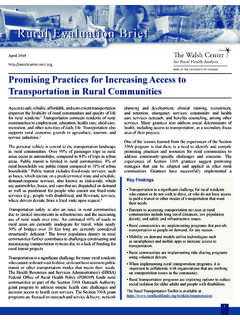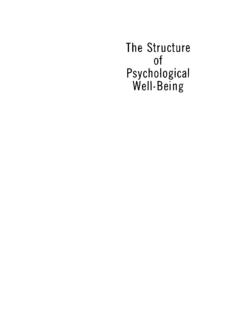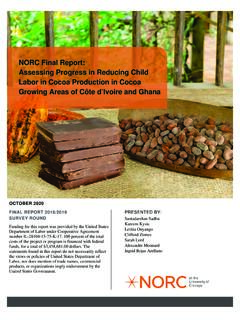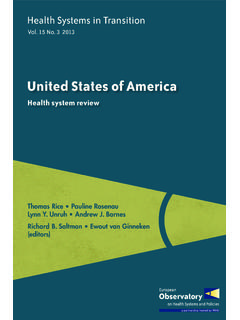Transcription of Rural Assets Final Report final - NORC at the University ...
1 Final Report Exploring Strategies to Improve Health and Equity in Rural Communities FEBRUARY 2018 PREPARED BY: NORC Walsh Center for Rural Health Analysis NORC | Exploring Strategies to Improve Health and Equity in Rural Communities Final Report | I The Walsh Center s mission is to conduct timely policy analyses and research that address the needs of government policy makers, clinicians, and the public on issues that affect health care and public health in Rural America. The Walsh Center is part of the Public Health Research Department at NORC at the University of Chicago, and its offices are located in Bethesda, Maryland. The Center is named in honor of William B.
2 Walsh, , whose lifelong mission was to bring health care to under-served and hard-to-reach populations. For more information about the Walsh Center and its publications, please contact: Michael Meit, MA, MPH The Walsh Center for Rural Health Analysis NORC at the University of Chicago 4350 East West Highway, Suite 800 Bethesda, Maryland 20814 301-634-9324 NORC | Exploring Strategies to Improve Health and Equity in Rural Communities Final Report | II Table of Contents Acknowledgements .. 1 Executive Summary .. 2 Introduction .. 8 Assets That Can Be Leveraged to Support Health and Equity in Rural Communities .. 10 Individual Assets .. 10 Organizational and Associational Assets .. 13 Community Assets .
3 16 Cultural Assets and Historical Context .. 18 Regional Perspective of Cultural Assets .. 20 Cross-Sector Change Agents, Champions, and Partners .. 23 Challenges to Improving Health and Equity in Rural Communities .. 27 Rural Priorities .. 27 Challenges .. 28 Opportunities for Action: Leveraging Strengths and Assets to Improve Health and Equity in Rural Communities .. 30 Appendix A: Methodology .. 40 Appendix B: Data Collection Agendas and Protocols .. 45 Appendix C: Participating Organizations .. 76 NORC | Exploring Strategies to Improve Health and Equity in Rural Communities Final Report | 1 Acknowledgements The NORC Walsh Center for Rural Health Analysis would like to thank the organizations that have contributed to this project.
4 Central to this effort are partnerships with several organizations to convene regional and national forums, provide feedback and guidance, and disseminate findings. Partners include: National Partners National Rural Health Association National Organization of State Offices of Rural Health National Association of Development Organizations National Association of Counties Regional Partners Southwest Center for Health Innovation Louisiana Public Health Institute Maine Rural Health Research Center Wisconsin Office of Rural Health East Tennessee State University College of Public Health We would also like to thank those organizations that participated in our national forum and key informant interviews.
5 AARP Foundation AcademyHealth Access Medcare American Association for State and Local History American Farm Bureau Federation American Hospital Association American Planning Association American School Health Association Appalachia Regional Commission Ascend at the Aspen Institute Association of Public Health Nurses Association of State and Territorial Health Officials Benedum Foundation Center for Rural Affairs Center for Rural Strategies Greater Clark Foundation Housing Assistance Council Institute for Rural Journalism and Community Issues Kate B. Reynolds Charitable Trust National Association of Area Agencies on Aging (n4a) National Association of Counties National Association of County and City Health Officials National Association of Development Organizations National Association of Rural Mental Health National Association of Social Workers National Association of State EMS Officials National Center for Rural Health Works National Community Pharmacists Association National Council of Churches National Council on Aging National Head Start Association National Organization of State Offices of Rural Health National Recreation and Park Association National Rural Education Association National Rural Health Resource Center National Rural Transit Assistance Program NTCA-The Rural
6 Broadband Association Public Library Association Rural Community Assistance Partnership Rural Support Partners Save the Children School Superintendents Association Small Urban and Rural Transit Center The American Legion University of North Dakota Center for Rural Health USDA National Institute of Food and Agriculture USDA Rural Development WK Kellogg Foundation YMCA of USA We would also like to extend our sincere appreciation to all of the individuals and organizations who participated in our regional meetings and vetting sessions, and to Dr. Melissa Schrift from East Tennessee State University for contributing her expertise in Rural health and culture to this project. Finally, we would like to thank the Robert Wood Johnson Foundation for their funding and support of this project,NORC | Exploring Strategies to Improve Health and Equity in Rural Communities Final Report | 2 Executive Summary The NORC Walsh Center for Rural Health Analysis conducted formative research to enhance understanding of strengths and Assets in Rural places, identify key partners and change agents, and identify opportunities to leverage Assets to improve Rural health and equity.
7 Following a literature synthesis, we engaged over 400 national and regional cross-sector stakeholders through a national discussion forum, key informant interviews, regional community forums, regional vetting sessions, formal partnerships, and feedback sessions at national conferences. Background Much of the research exploring Rural health and equity in the focuses on disparities, with limited attention to the strengths and Assets present in many communities and opportunities to leverage these capacities for improving health and equity. As documented by many researchers,1,2,3,4 Rural residents experience increased health risks related to geographic, socioeconomic, environmental and other factors unique to Rural communities.
8 While it is important to acknowledge and address these inequities and their root causes, it is essential to understand and leverage the strengths and Assets of Rural places that serve as protective factors and could fundamentally improve health and equity. This research was motivated by the Robert Wood Johnson Foundation s vision for building a Culture of Health5 where everyone in America has the opportunity for health and well-being. Our goal was to identify Assets that are commonly present in Rural communities and to understand how these Assets can accelerate changes to improve health and equity. While our work identified many common strengths and Assets in Rural communities, we found that there is variation in terms of how these strengths and Assets are operationalized in different communities.
9 Based on our findings, we offer recommendations for funders including philanthropies and government agencies and other community partners to engage with and support Rural communities to improve health and equity in ways that build upon their inherent strengths and Assets . 1 Meit, M., Knudson, A., Gilbert, T., Tzy-Chyi Yu, A., Tanenbaum, E., Ormson, E., .. Popat, S. (2014). The 2014 update of the Rural -urban chartbook. Retrieved from 2 Knudson, A., Meit, M., Brady, J., & Tanenbaum, E. (2013). Exploring Rural and urban mortality differences. Retrieved from 3 University of Wisconsin Population Health Institute. (2017). County Health Rankings Key Findings 2017.
10 Retrieved from 4 Moy, E. M., Garcia, , Bastian, B., Rossen, , Ingram, , Faul, M., .. Iademarco, M. F. (2017). Leading causes of death in nonmetropolitan and metropolitan areas United States, 1999 2014. MMWR Surveillance Summary;66(No. SS-1):1 8. 5 Robert Wood Johnson Foundation. (2017). Building a culture of health. Retrieved from NORC | Exploring Strategies to Improve Health and Equity in Rural Communities Final Report | 3 Findings This project used a capacity-oriented approach to identify the strengths and Assets of Rural communities exploring capacities found in communities that can be leveraged for positive change, rather than focusing on needs and deficiencies. Adapting an asset-based community development framework,6 we organized our findings into four categories: individual Assets ; organizational Assets ; community Assets ; and cultural Assets (see the Rural Asset Map developed to guide this project in Exhibit 1 on page 44).









